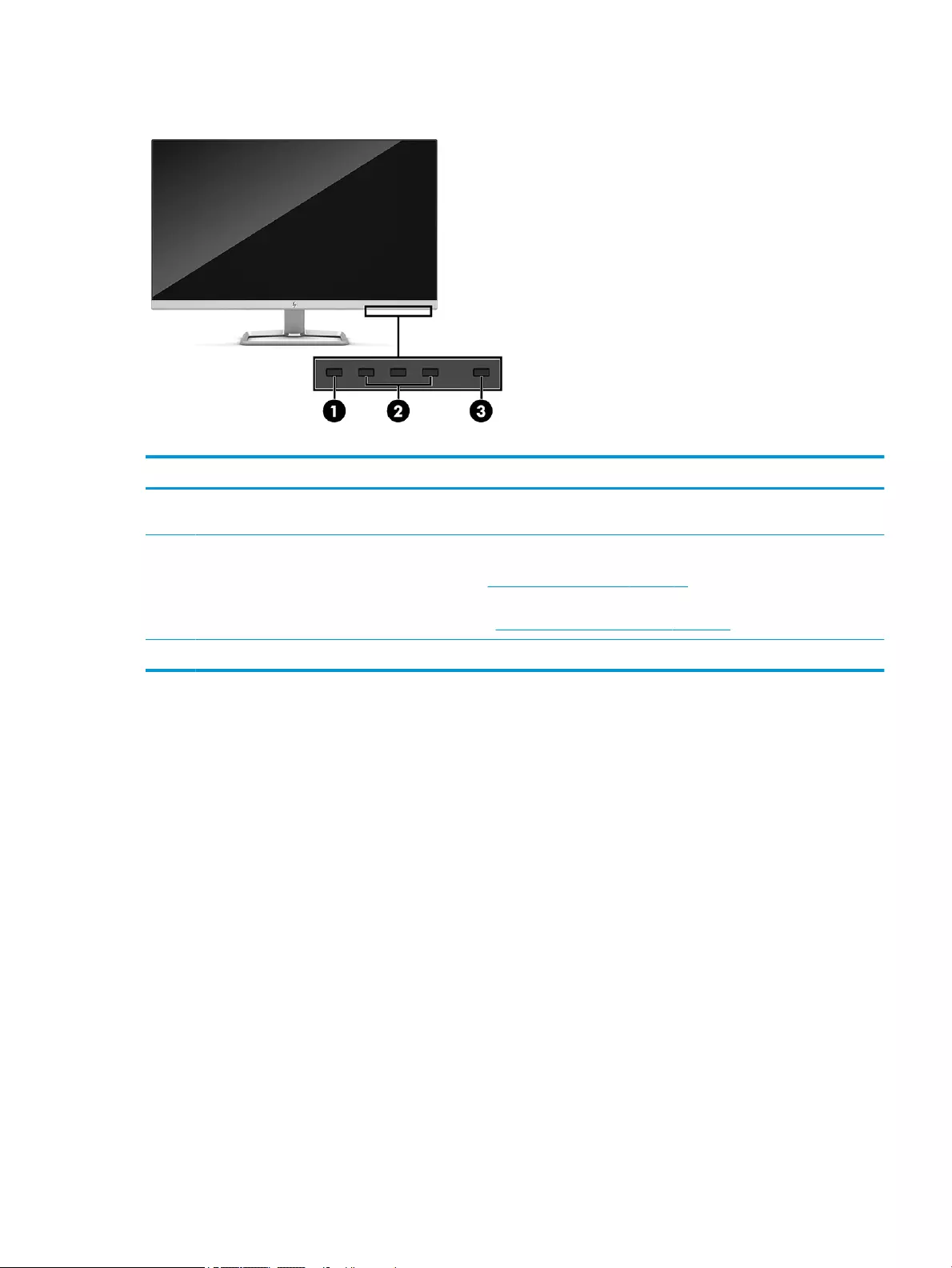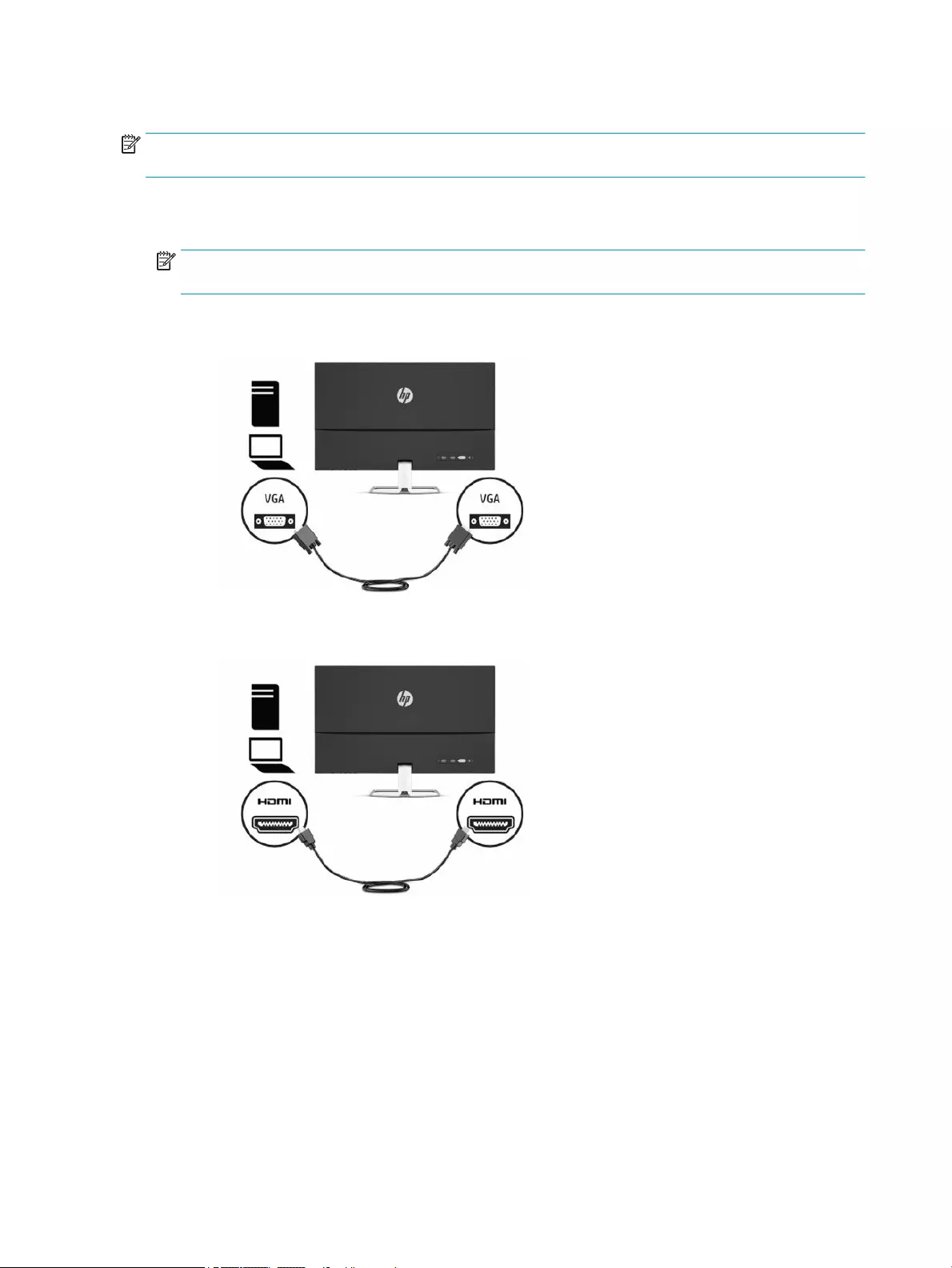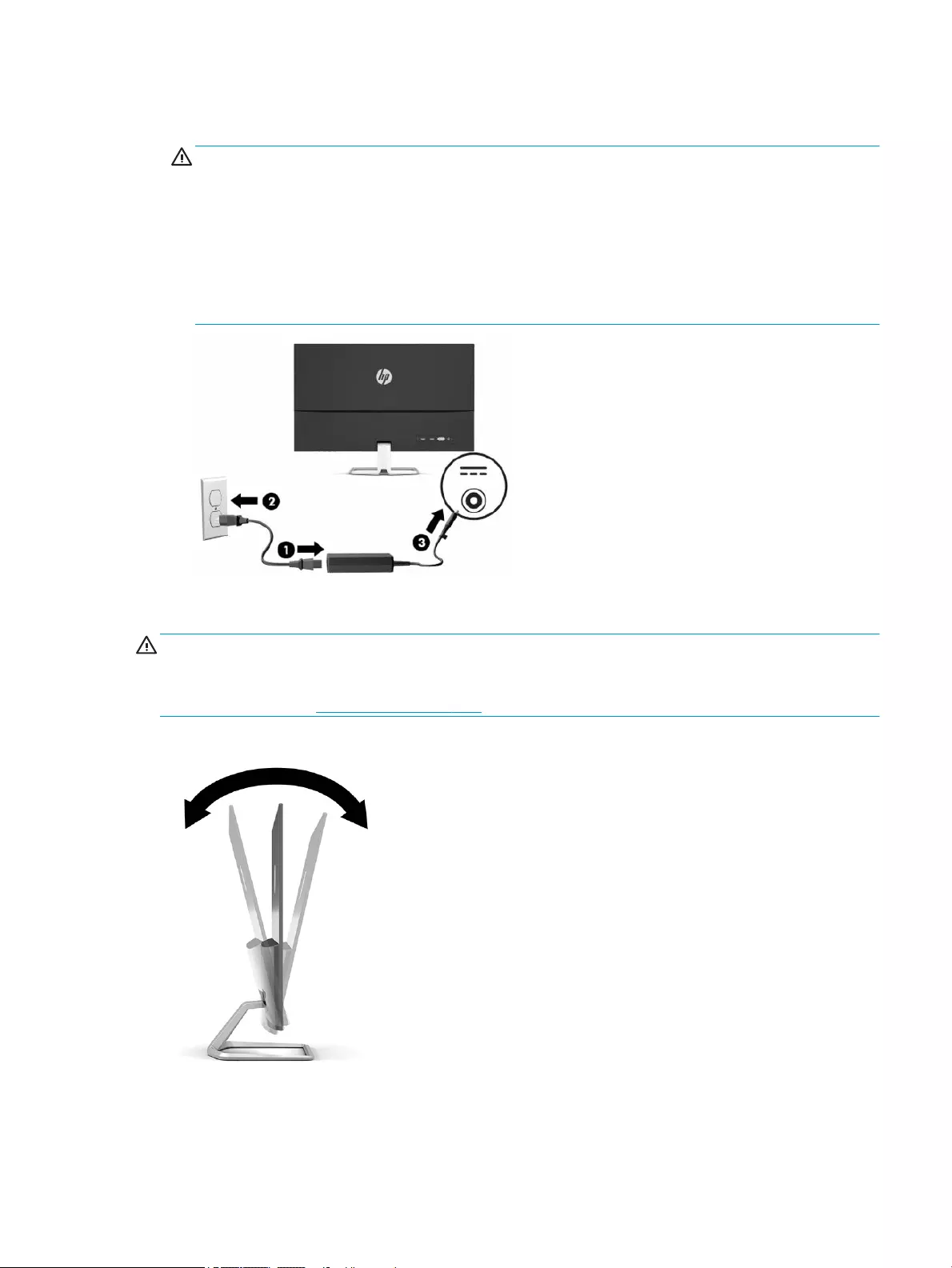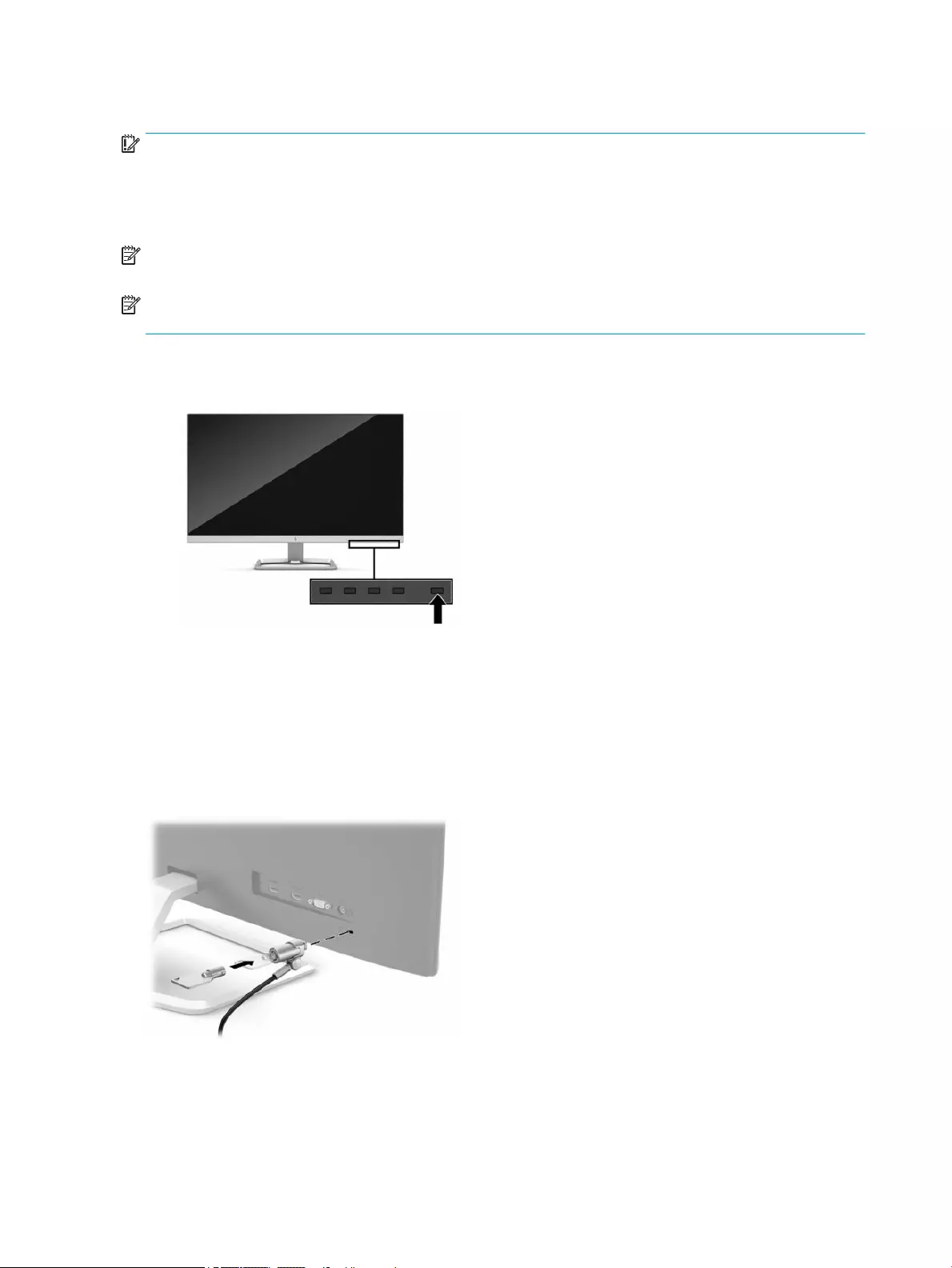Table of Contents
HP 32f User Manual
Displayed below is the user manual for 32f by HP which is a product in the Computer Monitors category. This manual has pages.
Related Manuals

User Guide

© Copyright 2019 HP Development Company,
L.P.
HDMI, the HDMI Logo and High-Denition
Multimedia Interface are trademarks or
registered trademarks of HDMI Licensing LLC.
Windows is either a registered trademark or
trademark of Microsoft Corporation in the
United States and/or other countries.
The information contained herein is subject to
change without notice. The only warranties for
HP products and services are set forth in the
express warranty statements accompanying
such products and services. Nothing herein
should be construed as constituting an
additional warranty. HP shall not be liable for
technical or editorial errors or omissions
contained herein.
Product notice
This guide describes features that are common
to most models. Some features may not be
available on your product. To access the latest
user guide, go to http://www.hp.com/support,
and follow the instructions to nd your
product. Then select User Guides.
First Edition: August 2019
Document Part Number: L68350-001

About This Guide
This guide provides information about monitor features, setting up the monitor, using the software and
technical specications.
WARNING! Indicates a hazardous situation that, if not avoided, could result in death or serious injury.
CAUTION: Indicates a hazardous situation that, if not avoided, could result in minor or moderate injury.
IMPORTANT: Indicates information considered important but not hazard-related (for example, messages
related to property damage). A notice alerts the user that failure to follow a procedure exactly as described
could result in loss of data or in damage to hardware or software. Also contains essential information to
explain a concept or to complete a task.
NOTE: Contains additional information to emphasize or supplement important points of the main text.
TIP: Provides helpful hints for completing a task.
This product incorporates HDMI technology.
iii

iv About This Guide

Table of contents
1 Getting Started ............................................................................................................................................. 1
Important safety information ............................................................................................................................... 1
Product features and components ........................................................................................................................ 2
Features ............................................................................................................................................... 2
Rear components ................................................................................................................................ 3
Front components ............................................................................................................................... 4
Setting up the monitor .......................................................................................................................................... 5
Installing the monitor stand ................................................................................................................ 5
Connecting the cables ......................................................................................................................... 6
Adjusting the monitor ......................................................................................................................... 7
Turning on the monitor ....................................................................................................................... 8
Installing a security cable .................................................................................................................... 8
2 Using the monitor .......................................................................................................................................... 9
Software and utilities ............................................................................................................................................ 9
The Information le ............................................................................................................................. 9
The Image Color Matching le ............................................................................................................. 9
Using the OSD menu ............................................................................................................................................ 10
Using the function buttons .................................................................................................................................. 11
Reassigning the function buttons ....................................................................................................................... 11
Adjusting blue light output (select products only) .............................................................................................. 12
Using Auto-Sleep Mode ....................................................................................................................................... 12
Changing the Power Mode setting ...................................................................................................................... 12
3 Support and troubleshooting ........................................................................................................................ 13
Solving common issues ....................................................................................................................................... 13
Button lockouts ................................................................................................................................................... 14
Contacting support .............................................................................................................................................. 14
Preparing to call technical support ..................................................................................................................... 14
Locating the serial number and product number ............................................................................................... 14
4 Maintaining the monitor .............................................................................................................................. 15
Maintenance guidelines ....................................................................................................................................... 15
Cleaning the monitor ......................................................................................................................... 15
Shipping the monitor ......................................................................................................................... 16
v

Appendix A Technical specications ................................................................................................................. 17
80.13 cm (31.55 in) model specications ........................................................................................................... 17
Preset display resolutions ................................................................................................................................... 18
80.13 cm/31.55 in model .................................................................................................................. 18
Power supply specication .................................................................................................................................. 18
Energy saver feature ........................................................................................................................................... 19
Appendix B Accessibility ................................................................................................................................. 20
HP and accessibility ............................................................................................................................................. 20
Finding the technology tools you need ............................................................................................ 20
The HP commitment ......................................................................................................................... 20
International Association of Accessibility Professionals (IAAP) ....................................................... 20
Finding the best assistive technology .............................................................................................. 21
Assessing your needs ..................................................................................................... 21
Accessibility for HP products .......................................................................................... 21
Standards and legislation .................................................................................................................................... 22
Standards .......................................................................................................................................... 22
Mandate 376 – EN 301 549 ............................................................................................ 22
Web Content Accessibility Guidelines (WCAG) ................................................................ 22
Legislation and regulations .............................................................................................................. 22
Useful accessibility resources and links .............................................................................................................. 23
Organizations .................................................................................................................................... 23
Educational institutions .................................................................................................................... 23
Other disability resources ................................................................................................................. 23
HP links .............................................................................................................................................. 24
Contacting support .............................................................................................................................................. 24
vi

1 Getting Started
Important safety information
A power cord is included with the monitor. If you use another cord, use only a power source and connection
appropriate for this monitor. For information about the correct power cord set to use with the monitor, see
the Product Notices provided in your documentation kit.
WARNING! To reduce the risk of electric shock:
• Plug the power cord into an AC outlet that is easily accessible at all times.
• If the power cord has a 3-pin attachment plug, plug the cord into a grounded (earthed) 3-pin outlet.
For your safety, do not place anything on power cords or cables. Care should be taken to route all cords and
cables connected to the monitor so that they cannot be stepped on, pulled, grabbed, or tripped over.
To reduce the risk of serious injury, read the Safety & Comfort Guide provided with your user guides. It
describes proper workstation setup and proper posture, health, and work habits for computer users. The
Safety & Comfort Guide also provides important electrical and mechanical safety information. The Safety &
Comfort Guide is also available on the Web at http://www.hp.com/ergo.
IMPORTANT: For the protection of the monitor and the computer, connect all power cords for the computer
and its peripheral devices (such as a monitor, printer, scanner) to a surge protection device such as a power
strip or uninterruptible power supply (UPS). Not all power strips provide surge protection; the power strip
must be specically labeled as having this capability. Use a power strip whose manufacturer oers a damage
replacement policy so you can replace the equipment if surge protection fails.
Use the appropriate and correctly sized furniture designed to properly support your monitor.
WARNING! Monitors that are inappropriately situated on dressers, bookcases, shelves, desks, speakers,
chests, or carts may fall over and cause personal injury.
NOTE: This product is suitable for entertainment purposes. Consider placing the monitor in a controlled
luminous environment to avoid interference from surrounding light and bright surfaces that may cause
disturbing reections from the screen.
Important safety information 1

Product features and components
Features
The monitor includes the following features:
●80.13 cm (31.55 in) diagonal viewable screen area with 1920 × 1080 resolution, plus full-screen support
for lower resolutions; includes custom scaling for maximum image size while preserving original aspect
ratio
●Antiglare panel with an LED backlight
●Wide viewing angle to allow viewing from a sitting or standing position, or when moving from side to
side
●Tilt adjustment capability
●High-Denition Multimedia Interface (HDMI) video inputs (cable provided)
●VGA video input (cable provided)
●Plug and Play capability, if supported by your operating system
●Security cable slot provision on rear of monitor for optional security cable
●On-screen display (OSD) adjustments in several languages for easy setup and screen optimization
●HP Display Assistant software for adjusting monitor settings and enabling the theft deterrence features
●High-bandwidth Digital Content Protection (HDCP) copy protection on all digital inputs
●Energy saver feature to meet requirements for reduced power consumption
NOTE: For safety and regulatory information, see the Product Notices provided in your documentation kit.
To access the latest user guide, go to http://www.hp.com/support and follow the instructions to nd your
product. Then select User Guides.
2 Chapter 1 Getting Started

Rear components
Table 1-1 Rear components
Component Function
1 HDMI port Connects an HDMI cable from the monitor to a source device
such as a computer.
2 HDMI port Connects an HDMI cable from the monitor to a source device
such as a computer.
3 VGA port Connects a VGA cable from the monitor to a source device such
as a computer.
4 Power light White: The monitor is on.
Amber: Monitor is in a reduced power state because of
inactivity. See Using Auto-Sleep Mode on page 12 for more
information.
5 Power connector Connects the power cord.
6 Security cable slot Connects an optional security cable to the monitor.
Product features and components 3

Front components
Table 1-2 Front components and their descriptions
Component Description
(1) Menu button Press to open the OSD menu, select a menu item from the OSD, or close the OSD menu.
When the OSD menu is open, the Menu light turns on.
(2) OSD buttons
(assignable)
When the OSD menu is open, press the buttons to navigate through the menu. The
function light icons indicate the default button functions. For a description of these
functions, see Using the function buttons on page 11.
You can reassign the function buttons to quickly select the most commonly used
operations. See Reassigning the function buttons on page 11.
(3) Power button Turns the monitor on or o.
4 Chapter 1 Getting Started

Setting up the monitor
WARNING! To reduce the risk of serious injury, read the Safety & Comfort Guide. It describes proper
workstation setup and proper posture, health, and work habits for computer users. The Safety & Comfort
Guide also provides important electrical and mechanical safety information. The Safety & Comfort Guide is
available on the Web at http://www.hp.com/ergo.
IMPORTANT: To prevent damage to the monitor, do not touch the surface of the LCD panel. Pressure on the
panel may cause nonuniformity of color or disorientation of the liquid crystals. If this occurs, the screen will
not recover to its normal condition.
IMPORTANT: To prevent the screen from getting scratched, defaced, or broken and prevent damage to the
control buttons, position the monitor facedown on a at surface covered with protective sheet foam or a
nonabrasive cloth.
Installing the monitor stand
TIP: Consider the placement of the monitor, because surrounding light and bright surfaces might cause
interfering reections.
1. Position the monitor facedown on a at surface covered by a protective sheet made of foam or a clean,
dry cloth.
2. Attach the top of the stand’s arm to the connector on the back of the monitor head.
Setting up the monitor 5

Connecting the cables
NOTE: The monitor ships with select cables. Not all cables shown in this section are included with the
monitor.
1. Place the monitor in a convenient, well-ventilated location near the computer.
2. Connect a video cable.
NOTE: The monitor automatically determines which inputs have valid video signals. You can select
inputs by pressing the Menu button to access the on-screen display (OSD) menu, and selecting Input.
●Connect one end of a VGA cable to the VGA port on the rear of the monitor and the other end to the
VGA port on the source device.
●Connect one end of an HDMI cable to the HDMI port on the rear of the monitor and the other end to
the HDMI port on the source device.
6 Chapter 1 Getting Started

3. Connect one end of the power cord to the power connector on the rear of the monitor and the other end
to a grounded AC outlet.
WARNING! To reduce the risk of electric shock or damage to the equipment:
Do not disable the power cord grounding plug. The grounding plug is an important safety feature.
Plug the power cord into a grounded (earthed) AC outlet that is easily accessible at all times.
Disconnect power from the equipment by unplugging the power cord from the AC outlet.
For your safety, do not place anything on power cords or cables. Arrange them so that no one may
accidentally step on or trip over them. Do not pull on a cord or cable. When unplugging the power cord
from the AC outlet, grasp the cord by the plug.
Adjusting the monitor
WARNING! To reduce the risk of serious injury, read the Safety & Comfort Guide. It describes proper
workstation setup and proper posture, health, and work habits for computer users. The Safety & Comfort
Guide also provides important electrical and mechanical safety information. The Safety & Comfort Guide is
available on the Web at http://www.hp.com/ergo.
Tilt the monitor head forward or backward to set it to a comfortable eye level.
Setting up the monitor 7

Turning on the monitor
IMPORTANT: Burn-in image damage may occur on monitors that display the same static image on the
screen for 12 or more consecutive hours. To avoid burn-in image damage, you should always activate a screen
saver application or turn o the monitor when it will not be in use for a prolonged period of time. Image
retention is a condition that may occur on all LCD screens. Burn-in damage on the monitor is not covered
under the HP warranty.
NOTE: If pressing the power button has no eect, the Power Button Lockout feature might be enabled. To
disable this feature, press and hold the monitor power button for 10 sec.
NOTE: You can disable the power light in the OSD menu. Press the Menu button to open the OSD, and then
select Power, select Power LED, and then select O.
1. Press the power button on the computer to turn it on.
2. Press the power button on the bottom of the monitor to turn it on.
When the monitor is rst turned on, a monitor status message displays for 5 sec. The message shows which
input is the current active signal, the status of the auto-switch source setting (On or O; default setting is On),
the current preset screen resolution, and the recommended preset screen resolution.
The monitor automatically scans the signal inputs for an active input and uses that input for the display.
Installing a security cable
You can secure the monitor to a xed object with an optional security cable available from HP.
8 Chapter 1 Getting Started

2 Using the monitor
Software and utilities
You can download and install the following les from http://www.hp.com/support:
●INF (Information) le
●ICM (Image Color Matching) les
●HP Display Assistant: Adjusts the monitor settings and enables theft deterrence features
To download the les:
1. Go to http://www.hp.com/support.
2. Select Software and Drivers.
3. Select your product type.
4. Enter your HP monitor model in the search eld and follow the on-screen instructions.
The Information le
The INF le denes monitor resources used by Windows® operating systems to ensure monitor compatibility
with the computer’s graphics adapter.
This monitor is Microsoft Windows Plug and Play–compatible, and the monitor will work correctly without
installing the INF le. Monitor Plug and Play-compatibility requires that the computer’s graphics card is VESA®
DDC2–compliant and that the monitor connects directly to the graphics card. Plug and Play does not work
through separate BNC-type connectors or through distribution buers or boxes.
The Image Color Matching le
The ICM les are data les that are used in conjunction with graphics programs to provide consistent color
matching from monitor screen to printer, or from scanner to monitor screen. This le is activated from within
graphics programs that support this feature.
NOTE: The ICM color prole is written in accordance with the International Color Consortium (ICC) Prole
Format specication.
Software and utilities 9

Using the OSD menu
Use the OSD menu to adjust the screen image based on your viewing preferences. You can access and make
adjustments in the OSD menu using the buttons on the monitor's front bezel.
To access the OSD menu and make adjustments:
1. If the monitor is not already on, press the power button to turn on the monitor.
2. Press the Menu button.
3. Use the three function buttons to navigate, select, and adjust the menu choices. The on-screen button
labels vary depending on which menu or submenu is active.
The following table lists menu selections in the OSD main menu.
Table 2-1 OSD main menu
Main Menu Description
Brightness Adjusts the brightness level of the screen. The factory default is 90.
Contrast Adjusts the contrast level of the screen. The factory default is 80.
Color Control Selects and adjusts the screen color.
Input Control Selects the video input signal.
Image Control Adjusts the screen image.
Power Control Adjusts the power settings.
Menu Control Adjusts the on-screen display (OSD) and function button controls.
Management Adjusts the DDC/CI settings and returns all OSD menu settings to the factory default settings.
Language Selects the language in which the OSD menu is displayed. The factory default is English.
Information Selects and displays important information about the monitor.
Exit Exits the OSD menu screen.
10 Chapter 2 Using the monitor

Using the function buttons
Pressing one of the function buttons activates the buttons and lights the icons above the buttons.
NOTE: The actions of the function buttons vary among monitor models.
For information about changing the function of the buttons, see Reassigning the function buttons
on page 11.
Table 2-2 Button names and descriptions
Button Icon Description
(1) Menu button Opens the OSD main menu, selects a menu item from the OSD, or closes the OSD
menu.
(2) Brightness button
Assignable function
button
Opens the Brightness menu where you can adjust the monitor screen brightness.
(3) Viewing Modes
button
Assignable function
button
Opens the Viewing Modes menu where you can adjust the monitor screen to a
comfortable viewing light or select a preset view mode.
(4) Next Active Input
button
Assignable function
button
Switches the monitor’s input source to the next active input.
Reassigning the function buttons
You can change the assignable function buttons from their default values so that when the buttons are
activated you can quickly access commonly used menu items. You cannot reassign the Menu button.
To reassign the function buttons:
1. Press the Menu button to open the OSD menu.
2. Select Menu, select Assign Buttons, and then select one of the available options for the button you
want to assign.
NOTE: To view an OSD menu simulator, visit the HP Customer Self Repair Services Media Library at
http://www.hp.com/go/sml.
Using the function buttons 11

Adjusting blue light output (select products only)
Decreasing the blue light emitted by the monitor reduces the blue light exposure to your eyes. This monitor
allows you to select a setting to reduce blue light output and create a more relaxing and less stimulating
image while you read content on the screen.
To adjust the blue light output from the monitor:
1. Press one of the OSD buttons to activate the buttons, and then press the Menu button to open the OSD.
Select Color Control and Viewing Mode.
2. Select your setting:
●Low Blue Light: (TUV certied) Reduces blue light for improved eye comfort.
●Reading: Optimizes blue light and brightness for indoor viewing.
●Night: Adjusts to the lowest blue light and reduces the impact on sleep.
3. Select Save and Return to save your setting and close the menu. Select Cancel if you do not want to
save the setting.
4. In the Main menu, select Exit.
Using Auto-Sleep Mode
The monitor supports an on-screen display (OSD) menu option called Auto-Sleep Mode that allows you to
enable or disable a reduced power state for the monitor. When Auto-Sleep Mode is enabled, the monitor
enters a reduced power state when the host computer signals low power mode, the absence of either
horizontal or vertical sync signal. Auto-Sleep Mode is enabled by default.
Upon entering this reduced power state (sleep mode), the monitor screen is blanked, the backlight is turned
o, and the power light indicator turns amber. The monitor draws less than 0.5 W of power when in this
reduced power state. The monitor wakes from the sleep mode when the host device sends an active signal to
the monitor (for example, if you activate the mouse or keyboard).
To disable Auto-Sleep Mode:
1. Press the Menu button to open the OSD.
2. In the OSD menu, select Power Control, select Auto-Sleep Mode, and then select O.
Changing the Power Mode setting
When in sleep mode, to comply with international power standards, the monitor default setting is Power
Saver mode. If your display supports Performance mode, then to keep the USB ports enabled even when the
monitor is in Auto-Sleep Mode, change the Power Mode setting from Power Saver to Performance.
To change the Power Mode setting:
1. Press the Menu button to open the OSD menu.
2. Select Power Control, select Power Mode, and then select Performance.
3. Select Save and close the OSD.
12 Chapter 2 Using the monitor

3 Support and troubleshooting
Solving common issues
The following table lists possible issues, the possible cause of each issue, and the recommended solutions.
Table 3-1 Common issues and solutions
Issue Possible Cause Solution
Screen is blank or video is
ashing.
Power cord is disconnected. Connect the power cord.
Monitor is turned o. Press the front bezel power button.
NOTE: If pressing the power button has no eect, press and
hold the power button for 10 sec to disable the Power Button
Lockout feature.
Video cable is improperly connected. Connect the video cable properly. See Connecting the cables
on page 6 for more information.
System is in sleep mode. Press any key on the keyboard or move the mouse to exit
sleep mode.
Video card is incompatible. Open the OSD menu and select the Input Control menu. Set
Auto-Switch Input to O and manually select the input.
Image appears blurred,
indistinct, or too dark.
Brightness is too low. Open the OSD menu and select Brightness to adjust the
brightness scale as needed.
Check Video Cable is
displayed on screen.
Monitor video cable is disconnected. Connect the appropriate video signal cable between the
computer and monitor. Be sure that the computer power is o
while you connect the video cable.
Input Signal Out of Range is
displayed on screen.
Video resolution and/or refresh rate
are set higher than what the monitor
supports.
Change the settings to a supported setting. See Preset display
resolutions on page 18 for more information.
The monitor is o but it did
not seem to enter into sleep
mode.
The monitor's power saving control is
disabled.
Open the OSD menu and select Power Control > Auto-Sleep
Mode and set auto-sleep to On.
OSD Lockout is displayed. The monitor's OSD Lockout function
is enabled.
Press and hold the Menu button on the front bezel for 10 sec
to disable the OSD Lockout function.
Power Button Lockout is
displayed.
The monitor's Power Button Lockout
function is enabled.
Press and hold the power button for 10 sec to disable the
Power Button Lockout function.
Solving common issues 13

Button lockouts
Holding down the power button or Menu button for 10 sec locks out the functionality of the buttons. You can
restore the functionality by holding the buttons down again for 10 sec. This functionality is only available
when the monitor is turned on, displaying an active signal, and the OSD is not open.
Contacting support
To resolve a hardware or software problem, go to http://www.hp.com/support. Use this site to get more
information about your product, including links to discussion forums and instructions on troubleshooting. You
can also nd information on how to contact HP and open a support case.
NOTE: Contact customer support to replace the power cord, the AC adapter (select products only), or any
other cables that shipped with your monitor.
Preparing to call technical support
If you cannot solve a problem using the troubleshooting tips in this section, you may need to call technical
support. Have the following information available when you call:
●Monitor model number
●Monitor serial number
●Purchase date on invoice
●Conditions under which the problem occurred
●Error messages received
●Hardware conguration
●Name and version of the hardware and software you are using
Locating the serial number and product number
The serial number and product number are located on a label on the bottom of the monitor head. You may
need these numbers when contacting HP about the monitor model.
NOTE: You may need to partially pivot the monitor head to read the label.
14 Chapter 3 Support and troubleshooting

4 Maintaining the monitor
Maintenance guidelines
To enhance the performance and extend the life of the monitor:
●Do not open the monitor cabinet or attempt to service this product yourself. Adjust only those controls
that are covered in the operating instructions. If the monitor is not operating properly or has been
dropped or damaged, contact an authorized HP dealer, reseller, or service provider.
●Use only a power source and connection appropriate for this monitor, as indicated on the label or back
plate of the monitor.
●Be sure that the total ampere rating of the products connected to the outlet does not exceed the current
rating of the AC outlet and that the total ampere rating of the products connected to the cord does not
exceed the rating of the cord. Look on the power label to determine the ampere rating (AMPS or A) for
each device.
●Install the monitor near an outlet that you can easily reach. Disconnect the monitor by grasping the plug
rmly and pulling it from the outlet. Never disconnect the monitor by pulling the cord.
●Turn the monitor o when it is not in use and use a screen saver program. Doing this can substantially
increase the life expectancy of the monitor.
NOTE: A burned-in image on the monitor is not covered under the HP warranty.
●Never block the slots and openings of the cabinet or push objects into them. These openings provide
ventilation.
●Do not drop the monitor or place it on an unstable surface.
●Do not allow anything to rest on the power cord. Do not walk on the cord.
●Keep the monitor in a well-ventilated area, away from excessive light, heat, or moisture.
Cleaning the monitor
1. Turn o the monitor and unplug the power cord from the AC outlet.
2. Disconnect any external devices.
3. Dust the monitor by wiping the screen and the cabinet with a soft, clean antistatic cloth.
4. For more diicult cleaning situations, use a 50/50 mix of water and isopropyl alcohol.
IMPORTANT: Do not use cleaners that contain any petroleum-based materials such as benzene,
thinner, or any volatile substance to clean the monitor screen or cabinet. These chemicals may damage
the monitor.
IMPORTANT: Spray the cleaner onto a cloth and use the damp cloth to gently wipe the screen surface.
Never spray the cleaner directly on the screen surface. It may run behind the bezel and damage the
electronics. The cloth should be moist, but not wet. Water dripping into the ventilation openings or other
points of entry can cause damage to the monitor. Allow the monitor to air-dry before use.
Maintenance guidelines 15

Shipping the monitor
Keep the original packing box in a storage area. You may need it later if you ship the monitor or move.
16 Chapter 4 Maintaining the monitor

A Technical specications
NOTE: All specications represent the typical specications provided by HP’s component manufacturers;
actual performance may vary either higher or lower.
For the latest specications or additional specications on this product, go to http://www.hp.com/go/
quickspecs/ and search for your specic monitor model to nd the model-specic QuickSpecs.
80.13 cm (31.55 in) model specications
Table A-1 80.13 cm (31.55 in) model specications
Specication Measurement
Display, wide-screen
Type
80.13 cm
IPS
31.55 in
Viewable image size 80.13 cm diagonal 31.55 in diagonal
Maximum weight (unpacked) 5.5 kg 12.13 lb
Dimensions (include base)
Height
Depth
Width
50.96 cm
22.64 cm
71.98 cm
20.046 in
8.91 in
28.34 in
Tilt –5° to 25°
Environmental requirements temperature
Operating temperature
Storage temperature
Storage humidity
5 to 35° C
–20 to 60° C
41 to 95° F
–4 to 140° F
5% to 95%
Power source 100 V ac –240 V ac 50/60 Hz
Input terminal Two HDMI ports and one VGA connector
80.13 cm (31.55 in) model specications 17

Preset display resolutions
The display resolutions listed in the following table are the most commonly used modes and are set as
factory defaults. The monitor automatically recognizes these preset modes, and they will appear properly
sized and centered on the screen.
80.13 cm/31.55 in model
Table A-2 Preset display resolutions
Preset Pixel format Horz freq (kHz) Vert freq (Hz)
1 640 × 480 31.469 59.940
2 720 × 400 31.469 70.087
3 800 × 600 37.879 60.317
4 1024 × 768 48.363 60.004
5 1280 × 720 45.000 60.000
6 1280 × 800 49.702 59.810
7 1280 × 1024 63.981 60.020
8 1440 × 900 55.935 59.887
9 1600 × 900 60.000 60.000
10 1680 × 1050 65.290 59.954
11 1920 × 1080 67.500 60.000
Table A-3 Preset timing resolutions
Preset Timing name Pixel format Horz freq (kHz) Vert freq (Hz)
1 480p 720 × 480 31.469 60
2 720p60 1280 × 720 45.000 60
3 1080p60 1920 × 1080 67.500 60
Power supply specication
Table A-4 Power supply specication
Manufacturer Model number Power supply rating
Delta ADP-40LD D 19 V dc / 2.1 A
Honor ADS-40NP-19–119040E 19 V dc / 2.1 A
18 Appendix A Technical specications

Energy saver feature
The monitors support a reduced power state. The reduced power state is initiated if the monitor detects the
absence of either the horizontal sync signal or the vertical sync signal. Upon detecting the absence of these
signals, the monitor screen is blanked, the backlight is turned o, and the power light turns amber. When the
monitor is in the reduced power state, the monitor uses <0.5 W of power. There is a brief warm-up period
before the monitor returns to its normal operating state.
See the computer manual for instructions on setting energy saver features (sometimes called power
management features).
NOTE: The power saver feature works only when the monitor is connected to a computer that has energy
saver features.
By selecting the settings in the monitor's Energy Saver utility, you can also program the monitor to enter into
the reduced power state at a predetermined time. When the monitor's Energy Saver utility causes the monitor
to enter the reduced power state, the power light blinks amber.
Energy saver feature 19

B Accessibility
HP and accessibility
Because HP works to weave diversity, inclusion, and work/life into the fabric of the company, it is reected in
everything HP does. HP strives to create an inclusive environment focused on connecting people to the power
of technology throughout the world.
Finding the technology tools you need
Technology can unleash your human potential. Assistive technology removes barriers and helps you create
independence at home, at work, and in the community. Assistive technology helps increase, maintain, and
improve the functional capabilities of electronic and information technology. For more information, see
Finding the best assistive technology on page 21.
The HP commitment
HP is committed to providing products and services that are accessible for people with disabilities. This
commitment supports the company's diversity objectives and helps ensure that the benets of technology
are available to all.
The HP accessibility goal is to design, produce, and market products and services that can be eectively used
by everyone, including people with disabilities, either on a stand-alone basis or with appropriate assistive
devices.
To achieve that goal, this Accessibility Policy establishes seven key objectives to guide HP actions. All HP
managers and employees are expected to support these objectives and their implementation in accordance
with their roles and responsibilities:
●Raise the level of awareness of accessibility issues within HP, and provide employees with the training
they need to design, produce, market, and deliver accessible products and services.
●Develop accessibility guidelines for products and services, and hold product development groups
accountable for implementing these guidelines where competitively, technically, and economically
feasible.
●Involve people with disabilities in the development of accessibility guidelines and in the design and
testing of products and services.
●Document accessibility features, and make information about HP products and services publicly
available in an accessible form.
●Establish relationships with leading assistive technology and solution providers.
●Support internal and external research and development that improves assistive technology relevant to
HP products and services.
●Support and contribute to industry standards and guidelines for accessibility.
International Association of Accessibility Professionals (IAAP)
IAAP is a not-for-prot association focused on advancing the accessibility profession through networking,
education, and certication. The objective is to help accessibility professionals develop and advance their
careers and to better enable organizations to integrate accessibility into their products and infrastructure.
20 Appendix B Accessibility

As a founding member, HP joined to participate with other organizations to advance the eld of accessibility.
This commitment supports HP’s accessibility goal of designing, producing, and marketing products and
services that people with disabilities can eectively use.
IAAP will make the profession strong by globally connecting individuals, students, and organizations to learn
from one another. If you are interested in learning more, go to http://www.accessibilityassociation.org to join
the online community, sign up for newsletters, and learn about membership options.
Finding the best assistive technology
Everyone, including people with disabilities or age-related limitations, should be able to communicate,
express themselves, and connect with the world using technology. HP is committed to increasing accessibility
awareness within HP and with our customers and partners. Whether it’s large fonts that are easy on the eyes,
voice recognition that lets you give your hands a rest, or any other assistive technology to help with your
specic situation—a variety of assistive technologies make HP products easier to use. How do you choose?
Assessing your needs
Technology can unleash your potential. Assistive technology removes barriers and helps you create
independence at home, at work, and in the community. Assistive technology (AT) helps increase, maintain,
and improve the functional capabilities of electronic and information technology.
You can choose from many AT products. Your AT assessment should allow you to evaluate several products,
answer your questions, and facilitate your selection of the best solution for your situation. You will nd that
professionals qualied to do AT assessments come from many elds, including those licensed or certied in
physical therapy, occupational therapy, speech/language pathology, and other areas of expertise. Others,
while not certied or licensed, can also provide evaluation information. You will want to ask about the
individual's experience, expertise, and fees to determine if they are appropriate for your needs.
Accessibility for HP products
The following links provide information about accessibility features and assistive technology, if applicable,
included in various HP products. These resources will help you select the specic assistive technology
features and product(s) most appropriate for your situation.
●HP Elite x3–Accessibility Options (Windows 10 Mobile)
●HP PCs–Windows 7 Accessibility Options
●HP PCs–Windows 8 Accessibility Options
●HP PC’s–Windows 10 Accessibility Options
●HP Slate 7 Tablets–Enabling Accessibility Features on Your HP Tablet (Android 4.1/Jelly Bean)
●HP SlateBook PCs–Enabling Accessibility Features (Android 4.3, 4.2/Jelly Bean)
●HP Chromebook PCs–Enabling Accessibility Features on Your HP Chromebook or Chromebox (Chrome
OS)
●HP Shopping–peripherals for HP products
If you need additional support with the accessibility features on your HP product, see Contacting support
on page 24.
Additional links to external partners and suppliers that may provide additional assistance:
●Microsoft Accessibility information (Windows 7, Windows 8, Windows 10, Microsoft Oice)
●Google Products accessibility information (Android, Chrome, Google Apps)
HP and accessibility 21

●Assistive Technologies sorted by impairment type
●Assistive Technologies sorted by product type
●Assistive Technology vendors with product descriptions
●Assistive Technology Industry Association (ATIA)
Standards and legislation
Standards
Section 508 of the Federal Acquisition Regulation (FAR) standards was created by the US Access Board to
address access to information and communication technology (ICT) for people with physical, sensory, or
cognitive disabilities. The standards contain technical criteria specic to various types of technologies, as well
as performance-based requirements which focus on functional capabilities of covered products. Specic
criteria cover software applications and operating systems, web-based information and applications,
computers, telecommunications products, video and multimedia, and self-contained closed products.
Mandate 376 – EN 301 549
The EN 301 549 standard was created by the European Union within Mandate 376 as the basis for an online
toolkit for public procurement of ICT products. The standard species the functional accessibility
requirements applicable to ICT products and services, together with a description of the test procedures and
evaluation methodology for each accessibility requirement.
Web Content Accessibility Guidelines (WCAG)
Web Content Accessibility Guidelines (WCAG) from the W3C's Web Accessibility Initiative (WAI) helps web
designers and developers create sites that better meet the needs of people with disabilities or age-related
limitations. WCAG advances accessibility across the full range of web content (text, images, audio, and video)
and web applications. WCAG can be precisely tested, is easy to understand and use, and allows web
developers exibility for innovation. WCAG 2.0 has also been approved as ISO/IEC 40500:2012.
WCAG specically addresses barriers to accessing the web experienced by people with visual, auditory,
physical, cognitive, and neurological disabilities, and by older web users with accessibility needs. WCAG 2.0
provides characteristics of accessible content:
●Perceivable (for instance, by addressing text alternatives for images, captions for audio, adaptability of
presentation, and color contrast)
●Operable (by addressing keyboard access, color contrast, timing of input, seizure avoidance, and
navigability)
●Understandable (by addressing readability, predictability, and input assistance)
●Robust (for instance, by addressing compatibility with assistive technologies)
Legislation and regulations
Accessibility of IT and information has become an area of increasing legislative importance. The links listed
below provide information about key legislation, regulations, and standards.
●United States
●Canada
●Europe
22 Appendix B Accessibility

●United Kingdom
●Australia
●Worldwide
Useful accessibility resources and links
The following organizations might be good resources for information about disabilities and age-related
limitations.
NOTE: This is not an exhaustive list. These organizations are provided for informational purposes only. HP
assumes no responsibility for information or contacts you encounter on the Internet. Listing on this page
does not imply endorsement by HP.
Organizations
●American Association of People with Disabilities (AAPD)
●The Association of Assistive Technology Act Programs (ATAP)
●Hearing Loss Association of America (HLAA)
●Information Technology Technical Assistance and Training Center (ITTATC)
●Lighthouse International
●National Association of the Deaf
●National Federation of the Blind
●Rehabilitation Engineering & Assistive Technology Society of North America (RESNA)
●Telecommunications for the Deaf and Hard of Hearing, Inc. (TDI)
●W3C Web Accessibility Initiative (WAI)
Educational institutions
●California State University, Northridge, Center on Disabilities (CSUN)
●University of Wisconsin - Madison, Trace Center
●University of Minnesota computer accommodations program
Other disability resources
●ADA (Americans with Disabilities Act) Technical Assistance Program
●ILO Global Business and Disability network
●EnableMart
●European Disability Forum
●Job Accommodation Network
●Microsoft Enable
Useful accessibility resources and links 23

HP links
Our contact webform
HP comfort and safety guide
HP public sector sales
Contacting support
NOTE: Support is in English only.
●Customers who are deaf or hard of hearing who have questions about technical support or accessibility
of HP products:
–Use TRS/VRS/WebCapTel to call (877) 656-7058 Monday through Friday, 6 a.m. to 9 p.m. Mountain
Time.
●Customers with other disabilities or age-related limitations who have questions about technical support
or accessibility of HP products, choose one of the following options:
–Call (888) 259-5707 Monday through Friday, 6 a.m. to 9 p.m. Mountain Time.
–Complete the Contact form for people with disabilities or age-related limitations.
24 Appendix B Accessibility